DIY cesspool - review and comparison of design options
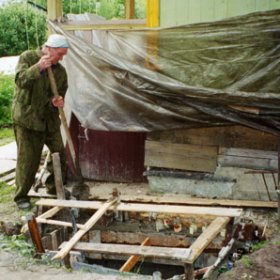
Utilities solve the problems of collecting and disposing of domestic wastewater for the townspeople, but the adherents of divided suburban life have to think through such vital issues on their own. If the owner of an estate intended for a large family, most often has to order the installation on the site of a volumetric septic tank or a local treatment station, then the summer resident can very well build a cesspool with inexpensive or waste materials. She will cope with the important sanitary function perfectly, and will not require the allocation of too much funds for the arrangement.
Content
The easiest and cheapest options
The historical predecessor of this sewer object was a simple hole dug in the ground, the walls of which were coated with clay, strengthened with boards. Then, old barrels, tanks, and other used tanks began to be buried in the ground. Now, such "reservoirs" for collecting and partially filtering wastewater are only suitable if the daily amount does not exceed a value of 1 cubic meter. m
An elementary cesspool for the toilet can satisfy the needs of summer residents staying on the site a couple of days a week in the summer season. However, its arrangement is not approved, and sometimes sanitary and epidemiological services are completely prohibited, often accompanying the prohibitions with administrative penalties.
Attention. The depth mark of the bottom should be at least 1 meter above the maximum (spring-autumn) groundwater level.
If the owner of the suburban area really does not want to spend money on the construction device, and he has a certain amount of worn tires, this material can be used with benefit. It will just be necessary to lay the tires in the excavated pit, fastening them together with bolts. If the pit is arranged outside the house or toilet, in the side of the tire to be laid on top, a hole must be cut out to connect the sewer pipe. After the pit, around the makeshift treatment plant, it is covered with soil, a concrete slab with an opening for the ventilation pipe and a hatch for pumping is laid on top.
Common types of designs
According to characteristic structural differences, cesspools are divided into absorbing structures and pressurized containers. The functions of collecting, accumulating and treating effluents are also performed by septic tanks.They are more complex installations in terms of technical aspects with forced stimulation of the movement of effluents inside and with biological and chemical cleaning methods.
Tanks without bottom - absorbing
Direct descendants of the "national" cesspool. Their characteristic feature is the absence of a bottom, due to which the liquid component of the effluent, after being cleaned by coarse filtration through a layer of a mixture of sand, gravel, broken brick and other “ingredients”, passes into the soil. The absorbing option is considered the most economical, in addition, a pit of this type can be completely implemented by a contractor who has absolutely no experience in the construction industry. Another saving: due to the partial infiltration of purified water into the soil, there is much less need to call the scavengers.
An absorbing variety of pits is chosen if there is no need to divert a large number of drains, if the country house does not have a jacuzzi, dishwashers and washing machines. A large amount of land will not be able to process and receive. In addition, the cleaning performed cannot be classified as one hundred percent effective procedures, which means that the effluents from the pit of the absorbing type will still pollute the environment.
Sealed Waste Tanks
There is a direct clue in their name that speaks of the main design feature. In fact, these are closed containers of water-tight concrete, masonry, plastic, gas silicate blocks, which need constant emptying after filling. Sealed structures will ensure the complete absence of odors inherent in the drains, but will force owners to regularly call a sewer machine to remove accumulations.
Important. For the construction of a cesspool, a cinder block is not applicable, it will collapse too quickly from contact with water.
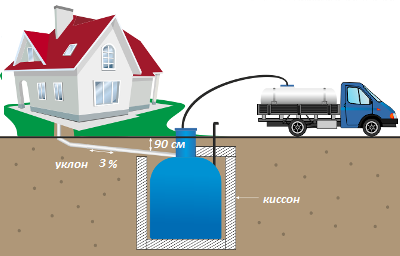
The easiest way is to buy and bury a factory plastic container for collecting wastewater in the ground, bring a sewer pipe to it and periodically call the dump trucks for emptying
The simplest scheme of the device for the sewage tank will be the installation of a plastic container purchased in a store. It does not need to be sealed, however, it is advisable to fill the bottom of the pit with a kind of cement screed and strengthen the walls with reinforcement. In principle, if the owners are not confused by the unpresentable appearance, then there is no need to bury it in the ground. Another strong argument in favor: a plastic structure can be installed regardless of the close level of groundwater. Any harm to the environment will not be inflicted anyway.
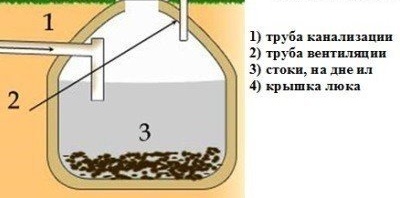
The tank should not be completely filled with sewage, between the manhole cover and the liquid level there should be at least one meter, if the level has exceeded the limit, the container should be emptied
The simplest home-made septic tanks
These are already more complex structures that perform not only deep cleaning, but also process the waste mass into a valuable fertilizer for gardeners and gardeners. Most often they are a system of two or three chambers, in the first of which only collection and rough mechanical cleaning takes place, and in the subsequent chambers specific bacteria enter the battle, finally processing the polluting inclusions of drains.
A cesspool with overflow purifies water so qualitatively that it can be successfully used for economic and technical purposes, for example, for irrigation or for cleaning a site. But in order to make a septic tank with overflow, considerable efforts will be required.
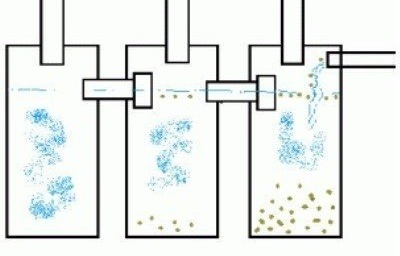
The principle of operation of the three-chamber septic tank consists in multi-stage wastewater treatment: in the first tank, the collected effluent is subjected to coarse filtration, in the following chambers finer cleaning
If the efforts are not a pity, but there is no surplus of financial resources, you can again resort to worn-out automobile tires. In the sense of "bald", but not worn to holes tires. Moreover, the owner will save not only due to the waste construction material. For the installation of a septic tank from tires, a powerful concrete foundation is not needed, a compacted pillow of crushed stone with sand with a capacity of 30-40 cm and a ten-centimeter screed are enough.
- To increase the volume of the created reservoir, the tire sidewalls must be cut off.
- A concrete pipe is mounted vertically in a well made up of tires; its diameter should be approximately half that of the same tire size. The upper section of the concrete pipe is 10 cm below the well made from tires.
- The bottom of the pipe is poured with concrete so that a monolithic concrete cylinder is obtained.
Above, you will need to make holes for infiltration and for installing pipes that provide overflow.
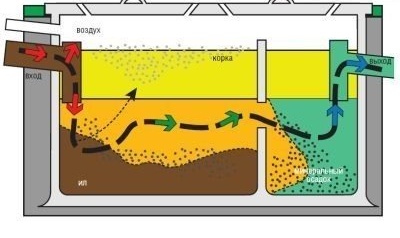
Cesspool design with overflow: the pipe entering the chamber should be located higher than the overflow pipe
- Sewer pipe must be introduced into the concrete tank located inside the tires.
Places for entering sewer pipes into vertically installed concrete pipes must be sealed.
How to make a cesspool with your own hands
Consider the stages of installation of several design options.
Absorbing
Owners of small suburban estates, who decided to make elementary sewers with their own hands, most often choose this option. Attracted by the simplest design and the ability to not too often resort to the services of sewage trucks. The walls can be laid out of bricks or gas silicate blocks, but it is easier and faster to build them by installing concrete rings on top of each other.
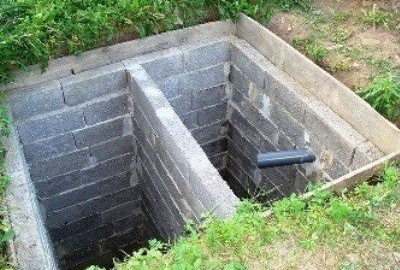
Building walls from gas silicate blocks is much faster than laying them out of brick, making a hole out of concrete rings even faster, but you need a crane to install them
- It is necessary to dig a pit of a mine type, the diameter of which will be approximately 80 cm larger than the diameter of the reinforced concrete ring. Rings will need 3 pieces.
- Around the perimeter, leaving the central part free, it is necessary to make a concrete screed, it will serve as a support base for the rings.
- In the bottom ring, it is necessary to drill holes through 10 cm so that the purified water can penetrate beyond the cesspool. Diameter of filtration holes 5 cm.
Important. The depth of the underground structure should not exceed a limit of 3 m, otherwise it would be difficult to extract a dense mud sediment settled at the bottom of the pit.
- About a meter built “well” should be filled with sand, gravel, broken brick, crushed stone mixed with soil.
- Such material is filled in the excavation from the outside. Before backfilling, waterproofing is carried out, protecting the structure from groundwater aggression and preventing the discharge of untreated sewage.
- At the end, a plate with two holes is installed. One of them is for the hatch through which it will be possible to clean, the second for the ventilation pipe.
Tip. In order to improve the quality of cleaning, it is recommended that the filtering well be supplemented with a sealed treatment tank with overflow located just above.
Sealed
The construction principle is similar, only it is not necessary to form holes for the infiltration of treated effluents and the bottom must be completely concreted. It is advisable to reinforce the lower concrete platform by laying concrete mesh on the bottom before pouring.So that the reinforcement does not “drown” in concrete, it needs to be slightly raised above the surface and mounted on pegs.
An important aspect: it is recommended to seal the walls. A cheap option for internal insulation is bitumen; on the outside, a homemade sewer can simply be coated with clay. If the walls of the pit were built of brick, they can be plastered.
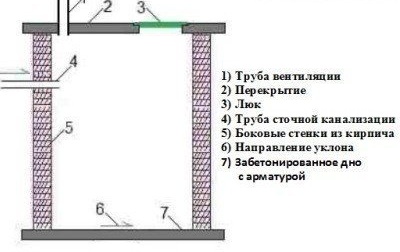
The standard design of a sealed cesspool with a concrete bottom, walls can be made of concrete rings, laid out with brick or gas silicate blocks, make a monolithic tank, pour concrete into the formwork
Masonry will take significantly more time than installing concrete rings. At the bottom, by analogy, a concrete screed is arranged, and you can lay bricks, both in a circle and by "drawing" a square or rectangle in the perimeter. The poured concrete platform should “mature” before masonry, having stood for 7-8 days.
Important. During the masonry, you need to form holes for the supply of the sewer pipe. The connection point is below the freezing level recorded by the local weather services.
The sewer pipe to the place of collection of effluents should be slightly inclined to ensure spontaneous movement of the contaminated mass.
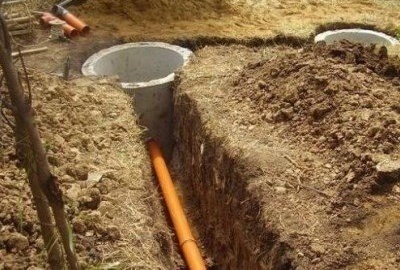
The pipe introducing the drains into the pit should be located below the freezing level, the pipeline should be laid at an angle to ensure spontaneous movement of the waste mass
Installation of ready-made complexes
It’s impossible to think of anything simpler and more convenient for their use, the arrangement of a cesspool of precisely calibrated components is made extremely quickly. The only drawback: manufacturer-specified volume parameters. But they produce a factory product mainly with the expectation of an average consumer. That is, to find the necessary kit is not difficult at all.
- The first thing is digging a pit according to the standard scheme for all pits.
- With their own hands, the owner will need to first make a pillow at the bottom of the mine from a mixture of concrete and gravel. It should grow stronger for a week, during which a kind of foundation needs to be slightly "irrigated" with water.
- Then order the delivery of the kit by car with a manipulator for the production of sequential installation of the bottom, rings, covers.
- Inside, it is advised to make an additional jumper to separate the contaminated runoff from purified water.
There are many ways and methods to make a cesspool. From the variety of options, it remains to choose the optimal type of design that meets the needs. Which costs are more important, what is the best way to save, choose the owner and the contractor, and knowledge of the design differences will help you make the right decision.
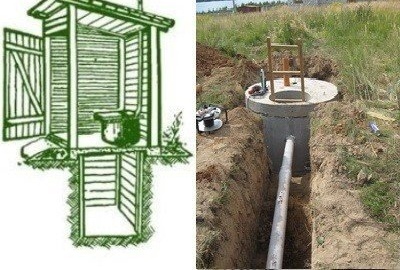
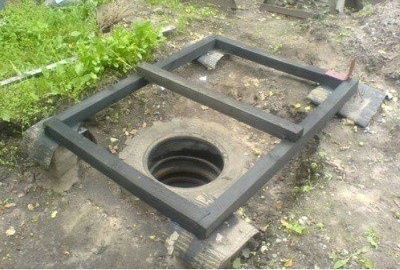
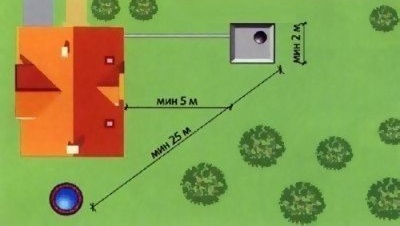
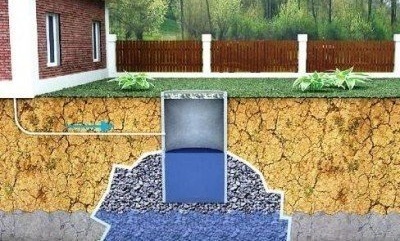

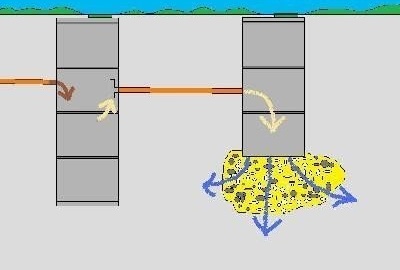
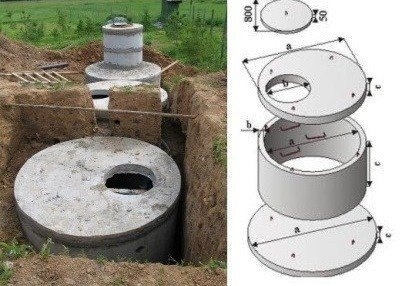
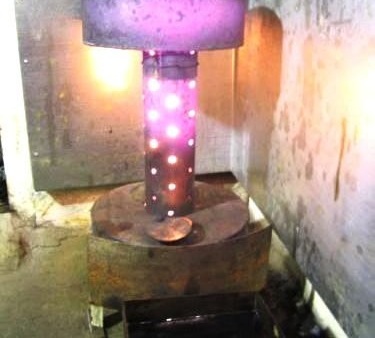
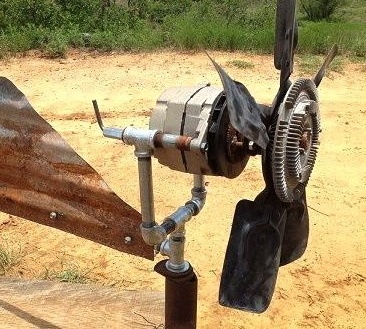

1 comment